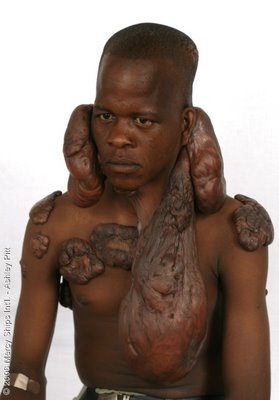
I first met Bawa at Screening day. Bawa had been to the ship before to have his keloids removed but it was about ten years ago. Unfortunately, Keloids can and do sometimes reappear bigger than before. Bawa was one of the first patients to have surgery here in Ghana this outreach.

The second time I saw Bawa, I was carrying him from the OR to the Ward(I am part of the Patient Transport Team). Bawa had his three biggest Keloids removed, combined they weighed over 8 pounds.
If you would like to know more about Bawa and his story please e-mail me and I will send you more info.
All photos are Property Mercy Ships Int'l. and should not be redistrubuted in any way.
For more detailed information about Keloids read below.
KeloidsAlternative names: Hypertrophic scar; Keloid scar; Scar - hypertrophic
Definition:Keloids are an overgrowth of scar tissue at the site of a healed skin injury.
Keloidosis
is a term used when multiple or repeated keloids are produced.
How can you get it:Keloids occur from such skin injuries as surgical incisions, traumatic wounds, vaccination sites, burns, chickenpox acne, or even minor scratches. They are fairly common in young women and African Americans. Most keloids will flatten and become less noticeable over a period of several years. They may become irritated from rubbing on clothing or other forms of friction. Extensive keloids may become binding, limiting mobility. They may cause cosmetic changes and affect the appearance. Exposure to the sun during the first year of the keloid's formation will cause the keloid to tan darker than surrounding skin. This dark coloration may become permanent.
Symptoms:A skin lesion that is:
Flesh-colored, red, or pink
Located over the site of a wound, injury, or other lesion
Nodular or ridged
The lesion may itch during formation and growth
Diagnosis:
Diagnosis is made on the basis of the appearance of the skin or scar. A skin biopsy may be needed to rule out other skin growths (tumors)
Treatment:Keloids often require no treatment. Keloids may be reduced in size by freezing (
cryotherapy), external pressure, corticosteroid injections, laser treatments, radiation, or surgical removal. It is not unusual for keloids to reappear (sometimes larger than before) after they have been removed.
Discoloration from sun exposure can be prevented by covering the forming keloid with a patch or Band-Aid, and by using sun block when spending time in the sun. These extras protection measures should be continued for at least 6 months after injury or surgery for an adult, up to 18 months for a child.
Expectations (prognosis):
Keloids usually are not medically dangerous, but they may affect the cosmetic appearance. In some cases, they may spontaneously reduce in size over time. Removal or reduction may not be permanent, and surgical removal may result in a larger keloid scar.
Complications:Psychological distress if keloid is large or disfiguring
Recurrence of keloid
Discomfort, tenderness, irritation of the keloid
Information was found at
Medline Plus Medical Encyclopedia











